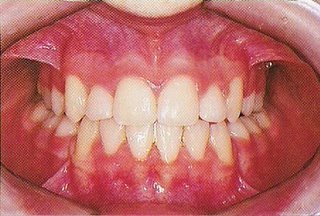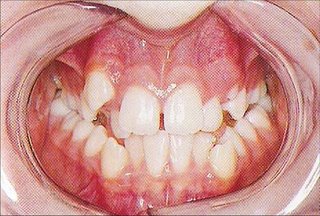
 Top: After braces treatment
Top: After braces treatmentBefore braces treatment
Can you be too old for braces?
There is no age limit for braces. As long as you have good periodontal health, braces can be used to straighten your teeth and correct your bite. More people over age 30 are getting braces today than ever before. Most ArchWired readers are between the ages of 30 and 55!
What is a malocclusion?
Occlusion is another word for your bite -- how the teeth in your top and bottom jaw meet with each other. So, a malocclusion means a bad bite -- a bite with problems.
What are the "classes" of malocclusion?
Malocclusion is most often caused by hereditary factors such as an abnormal relationship between the size of the teeth and the size of the jaws. Malocclusion may also result from missing teeth or habits such as thumb sucking or tongue thrusting.
Malocclusions are classified based on the relationship of the maxillary (upper jaw) and mandibular (lower jaw) first permanent molars.
There are three basic classes of malocclusion, Class I, Class II, and Class III:
Class I malocclusion involves crowding, spacing, or overlapping of the teeth. In this classification the upper jaw is in a normal relationship to the lower jaw; that is, neither jaw protrudes.
Class II malocclusion occurs when the bottom jaw is in a more posterior (backward) position than normal. The top teeth appear to protrude out over the lower teeth. One example of this type of malocclusion is often referred to as "buck" teeth.
Class III malocclusion occurs when the lower jaw is in a more anterior (forward) position than normal. The lower teeth protrude out beyond the upper teeth. This is often the most difficult type of malocclusion to correct.
How much do braces cost?
The average cost for a full set of braces in a typical two-year treatment is about $5,000 US. The cost varies depending on where you live. Major metropolitan areas tend to be slightly higher in cost than rural areas. Generally, metal braces cost less than ceramic. Invisalign treatment can be just as costly as traditional braces, and sometimes is even slightly more expensive.
Can I get braces just on the top or bottom?
That depends on your case. Orthodontics isn't just about making your teeth straight or making them look better. Most dentists and orthodontists take a lot of things into consideration when recommending treatment, such as:
1.how the top and bottom teeth meet with each other (i.e., your bite)
2.how well you can chew your food
3.whether you have a tongue thrust problem
4.whether extraction or surgery will be necessary to correct your problems
5.whether you will need any appliances in your treatment, such as a palate expander or headgear (yes, some adults do wear headgear)
So you see, it isn't just a matter of making your teeth look pretty. There are lot of other factors to take into consideration. This is why you sometimes need a full set of braces, even if you think that you only need them on top or bottom. Of course, some people are lucky. Their bites are good and perhaps they only need a bit of straightening. People in this position often can get braces only on top or bottom
When will I begin to see changes in my teeth after the braces are put on?
According to a recent ArchWired poll, most people begin see changes in their teeth in the first 2 to 6 weeks of treatment.
Should I get teeth extracted as part of my orthodontic treatment?
It depends on your specific case. When we are young and our jaws are still growing, dentists/orthodontists can work with our growth to straighten the teeth without extraction.
But once we are adults, dentists are limited to what is already in place. If your orthodontist recommends extraction, it may be wise to get at least one more (if not two more) opinions before going through with the procedure -- once the teeth are gone, they're gone! Sometimes, depending on your unique case, extraction may be the only way to successfully straighten your teeth and correct your bite.
How long does it take to close gaps between teeth after an extraction?
That depends on your unique physiology. Gaps in teeth on the lower jaw tend to close slower than on the upper jaw. It can take anywhere from a few months to a year to close extraction gaps.
No comments:
Post a Comment